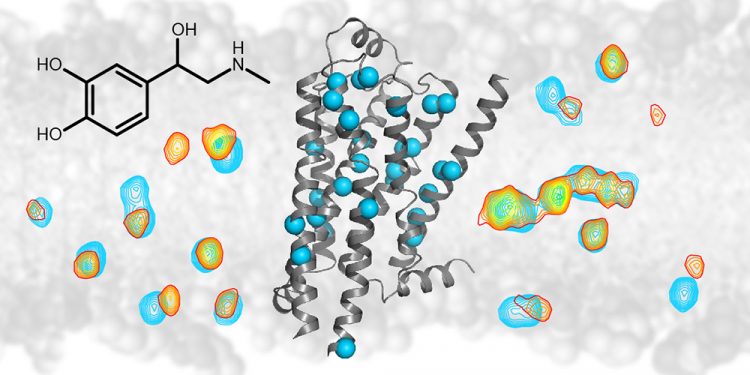New insights into the function of the main class of drug targets

The NMR technology detects signals (shown as contour lines) from individual atoms (blue spheres) of the β1-adrenergic G protein coupled membrane receptor (grey ribbon diagram). Upon binding of drugs such as adrenalin (black chemical structure) the signals from the atoms change (from blue to yellow/red contours). This change allows the effect of drug binding to be followed throughout the receptor. © University of Basel, Biozentrum
A wide variety of drugs such as beta-blockers against high blood pressure or drugs against allergies, cancer, Parkinson’s disease, HIV and others bind to cell surface proteins which belong to the family of G protein coupled receptors. The drug binding transmits a signal to the inside of the cell. Despite the fact that many structures of these receptors are known, it remained unclear how the signal is transmitted to the intracellular inside.
To better understand the signal transduction function, Prof. Stephan Grzesiek’s team at the Biozentrum of the University of Basel, together with researchers from the Paul Scherrer Institute (PSI) have studied in detail one receptor – the β1-adrenergic receptor. Using Nuclear Magnetic Resonance spectroscopy (NMR), the scientists have been able to follow the motions of this receptor in response to various drugs, and have thus obtained unprecedented detailed insights into the general mechanism of G protein coupled receptor function.
Structural changes provide details on receptor function
The β1-adrenergic receptor is a protein embedded in the membrane of cardiac cells. It translates the binding of extracellular drug molecules into the activation of intracellular proteins. The hormone noradrenaline, for example, induces a signaling cascade in the cell, which at the end increases heart rate and blood pressure. So-called beta-blockers impede these effects by preventing the hormone from binding to the adrenergic receptor. Thereby, they reduce the heart rate. Structural details of the signal transduction caused by such receptor-ligand interactions have so far remained unclear.
“We have applied high resolution NMR to analyze the structural changes of the β1-adrenergic receptor upon binding of various drugs”, explains first author Shin Isogai. “We could observe how the receptor recognizes the binding partner, interprets its chemical structure and transmits this information to the inside of the cell by changing its structure. This insight into the functionality of the β1-adrenergic receptor at the atomic level can be applied to the whole family of G protein coupled receptors, which are well known as important drug targets.”
Prediction of drug efficacy
Using the NMR observation of the atomic nuclei, the scientists could see how deep the drugs insert into the receptor from the outside, how the drug pushes certain groups away and how it transmits this mechanical signal to the inside. Thus they identified crucial mechanical connections for the signal transmission within the receptor structure. The NMR signals also revealed the binding strength of the drugs and their potency to trigger an intracellular response. In fact, they could follow how a model protein for the intracellular response binds to the activated receptor.
“We are very happy that we could see these details. The receptors are notoriously difficult to study. Many researchers have tried for more than a decade”, emphasizes Isogai. “Now we can apply this method to see the function of individual amino acids and to study other receptors.” In the future, the NMR method may also be used for drug screening and drug development.
Original article:
Shin Isogai, Xavier Deupi, Christian Opitz, Franziska M. Heydenreich, Florian Brueckner, Gebhard F.X. Schertler, Dmitry B. Veprintsev and Stephan Grzesiek. Backbone NMR reveals allosteric signal transduction networks in the β1-adrenergic receptor. Nature; published online 3 February 2016.| doi: 10.1038/nature16577
Further information
Stephan Grzesiek, Universität Basel, Biozentrum, Tel.+41 61 267 21 00, E-Mail: stephan.grzesiek@unibas.ch
Media Contact
More Information:
http://www.unibas.chAll latest news from the category: Life Sciences and Chemistry
Articles and reports from the Life Sciences and chemistry area deal with applied and basic research into modern biology, chemistry and human medicine.
Valuable information can be found on a range of life sciences fields including bacteriology, biochemistry, bionics, bioinformatics, biophysics, biotechnology, genetics, geobotany, human biology, marine biology, microbiology, molecular biology, cellular biology, zoology, bioinorganic chemistry, microchemistry and environmental chemistry.
Newest articles

High-energy-density aqueous battery based on halogen multi-electron transfer
Traditional non-aqueous lithium-ion batteries have a high energy density, but their safety is compromised due to the flammable organic electrolytes they utilize. Aqueous batteries use water as the solvent for…

First-ever combined heart pump and pig kidney transplant
…gives new hope to patient with terminal illness. Surgeons at NYU Langone Health performed the first-ever combined mechanical heart pump and gene-edited pig kidney transplant surgery in a 54-year-old woman…

Biophysics: Testing how well biomarkers work
LMU researchers have developed a method to determine how reliably target proteins can be labeled using super-resolution fluorescence microscopy. Modern microscopy techniques make it possible to examine the inner workings…





















